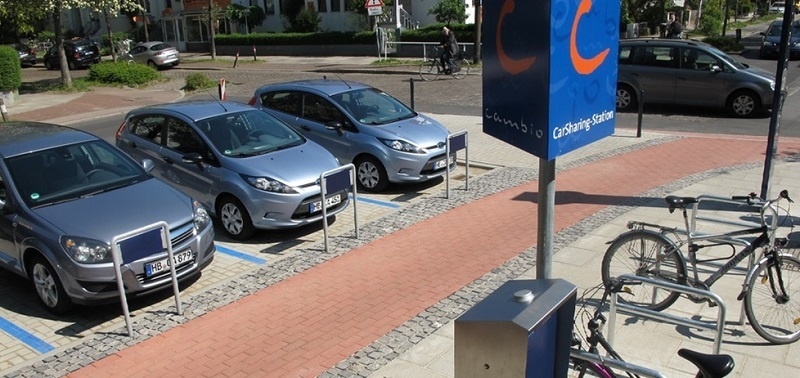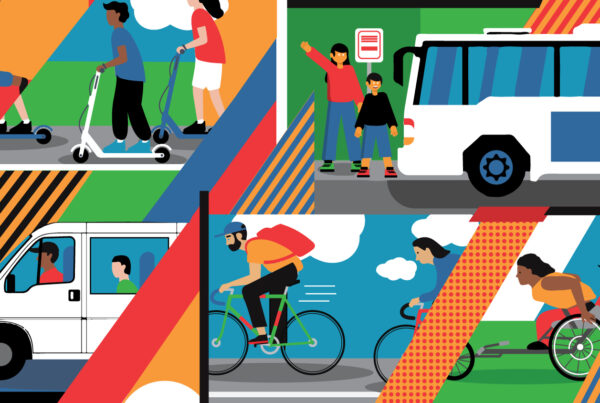Michael Glotz-Richter first came upon the idea of integrated mobility hubs nearly two decades ago, when looking for new solutions to reduce the number of cars on the road in Bremen, Germany and reclaim street space for other uses.
Mobility hubs—a new idea then, and still far from common today—combine multiple modes of transportation together in one physical location, often clustered around a high-frequency public transit stop. Typical components include carshare stations, bike parking, wayfinding elements and universal fare payment via a single smartcard or mobile app.
Because mobility hubs make it easy to access a wide range of travel options for different trip types, they can help to reduce reliance on private autos and support multimodal lifestyles.
As the senior project manager of sustainable mobility for the City of Bremen, Michael believed these hubs could help address increasing traffic congestion and parking pressures. Thanks to his efforts, the first Mobil.Punkt (“Mobility Point”) stations—featuring carsharing, bike parking and transit—launched in 2003, and today number more than 25. The hubs have succeeded in promoting more sustainable forms of transportation, and a recent analysis suggested Bremen’s 290 carshare cars have removed more than 4,200 privately owned cars from the road.
As U.S. cities such as Los Angeles and Seattle now work to build mobility hubs of their own, we asked Michael to share his advice and lessons learned from his work over the last 15 years.
- Build Around Strong Transit Stops
“Transit is the cornerstone to creating a life where you don’t need to depend on car ownership,” says Michael. At the Shared-Use Mobility Center, we also often describe public transit as the “backbone” that helps to support a diverse, equitable transportation system.
It’s hard to get people to get out of their cars if there aren’t enough alternatives. And it’s hard to support a diverse array of options without transit, which is affordable, serves long-distance trips, and is often used for commuting.
So, it shouldn’t come as a surprise that, when selecting a site for a new mobility hub, the first thing Michael looks for is a thriving transit stop to build around.
- Target Areas with High Parking Pressure
To have the biggest impact on mode shift, it’s also important to target areas where pressure on street parking is high.
“We want to get into areas where people are a little pissed off with car ownership,” Michael says. “The willingness to give up private cars is higher when owning a car is a pain in the butt.”
With the hassle of car ownership acting as a behavioral “stick,” mobility hubs can help offer a variety of alternatives to encourage people to make the switch to more sustainable modes of transport.
It also helps to find areas where a significant amount of travel is already taking place by cycling or walking, Michael says—in other words, where active transportation choices are a reasonable alternative and are able to capture a higher share of private auto trips.
Even though parking may be at a premium, cities shouldn’t be afraid to dedicate street space to mobility hubs. For instance, limited street space did not stop the City of Bremen from taking away even more spaces for carsharing and other shared modes. Bremen has also focused on integrating carsharing into new residential developments, and revised its regulations to allow developers to make carsharing available instead of building expensive individual parking spaces.
- Get As Close As Possible to Your Users
“The next thing we learned is that it’s important for hubs to be close to the needs of their users,” Michael says. “They should be close to where people live, or to the buildings where they work.”
To infiltrate into dense city neighborhoods with narrow streets, the City of Bremen developed a second, smaller type of Mobil.Punkt called “mobil.pünktchen” (a pünktchen is a small dot or point). These sites, of which there are now 15, simply feature 2-3 carshare cars parked on the street in parallel to the curb, and work as a complement to the larger hubs. (The City plans to implement 10 to 15 additional ‘mobil.pünktchen’ stations each year.)
According to Michael, when it comes to everyday use, 70 to 80 percent of demand is for compact cars. Vehicles that people use more occasionally, like vans or large sedans, are better located at larger mobility hubs where there’s more space. And since people don’t use these vehicles on a daily basis, they don’t mind traveling a little further to a larger hub to access them.
- Leverage Mobile Technology for Wayfinding and Fare Integration
A good mobility hub should help make transfers between modes as seamless as possible. To support multimodal trip planning, many hubs feature wayfinding resources via tablets, interactive kiosks or physical maps.
Fare integration is another important element, and one where Germany – which has nearly 40 different local transit systems all operating on the same fare system – is admittedly at an advantage. (The country’s national railway, Deutsche Bahn, also operates its own carsharing and bikesharing services.)
However, some U.S. cities are making progress on integrating new forms of shared mobility and transit together into the same systems. In the Twin Cities, HourCar users have been able to access carshare vehicles using their transit pass for years. In Los Angeles, Metro Bike Share members can use their TAP cards to check out bikes. And agencies such as TriMet in Portland have been working to develop mobile apps that combine trip planning and payment for many modes together in one place.
Users of Bremen’s Mobil.Punkt hubs can also connect with a call center, whose staff can handle bookings for taxis and carshare cars. Some cities also have plans to make mobility hubs Wi-Fi hotspots, which can help increase access to residents who have smartphones but no data plans, while also providing an added amenity for travelers and helping to support place-making efforts.
- Use Mobility Hubs to Promote Multimodal Living, Not (Necessarily) Multimodal Trips
While seamless transfers and first/last mile connections to transit are important, Michael says that, ultimately, mobility hubs should be about encouraging multimodal living, not multimodal trips.
To change travel behavior, shared mobility must be able to compete with the convenience of the private automobile. And that’s hard to do when you factor in added time and hassle from transfers between modes.
“Just go to the needs of the user,” Michael says. “Car trips are generally point-to-point. You wouldn’t normally take transit and then a car, for instance.”
While encouraging connections is an integral part of the mobility hub concept, Michael suggests that mobility hubs are at their best when serving as a “one-stop-shop” where riders can walk up and select a mobility option that best meets their needs for the day.
- Make Mobility Hubs Visible
“Mobil.Punkt is well known,” says Michael. “It’s a brand, and it’s also quite symbolic—you are proudly presenting your service. Accessibility and visibility are really important.”
Every Mobil.Punkt station is marked with a big blue pillar and conspicuous signage. To make sure that local residents are aware of new hubs, Michael and his team also engage in hands-on community outreach, including putting up flyers, sending out mailers to neighborhood residents and meeting with local groups and stakeholders.
“The most important thing is awareness, awareness, awareness,” says Michael.
- Market Mobility Hubs
The City of Bremen has also employed a variety of marketing campaigns over the years to promote the Mobil.Punkt program. Michael developed a cartoon mascot named “Udo” (short for “use, don’t own”) to highlight the convenience of mobility hubs (“We put convenience front and center, not environmental benefits,” says Michael).
The city has also advertised on billboards and signage near public transit stops, staged an elaborate celebration on the 10th anniversary of the Mobil.Punkt program, and developed a series of promotional videos that show James Bond fleeing a Russian agent via bikesharing and carsharing, while his car-using adversary sits in traffic.
Michael’s efforts to promote the mobility hub concept have also extended to the national level, and even internationally. In 2010, Mobil.Punkt was selected as an “urban best practice” at EXPO 2010 in Shanghai, and was featured in a pavilion display that was visited by more than 1 million attendees.
For more information on mobility hubs, you can read Michael’s paper on Sustainable Urban Mobility Plans. To keep up to date about SUMC’s work on mobility hubs and other issues, be sure to sign up for our regular newsletter.
Image credit: mobil.punkt


